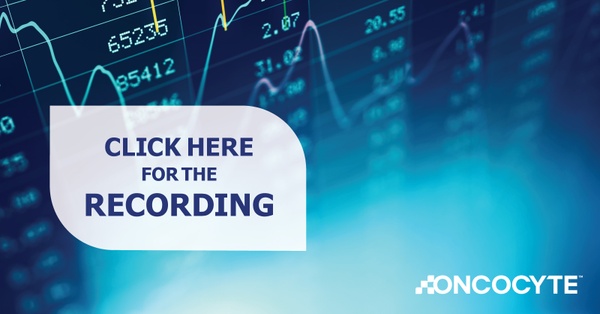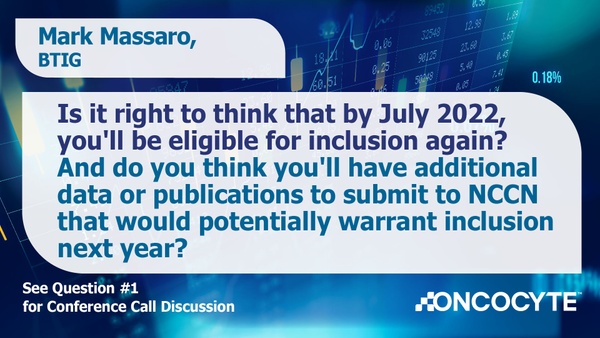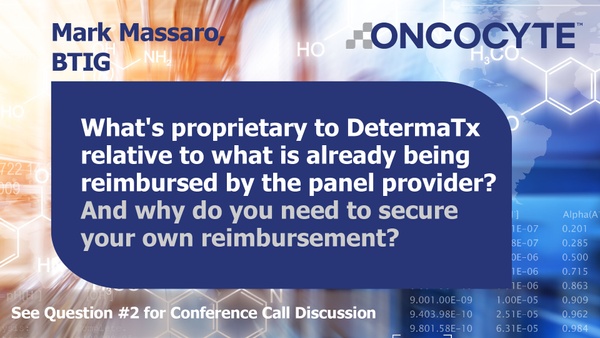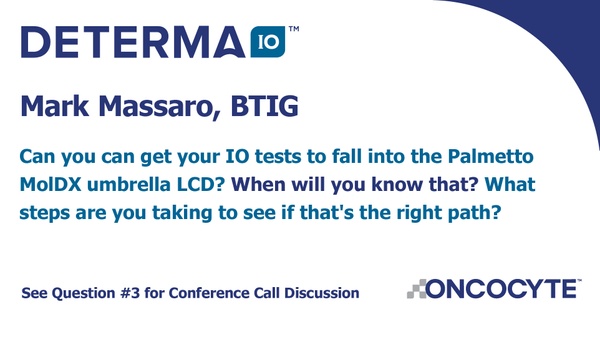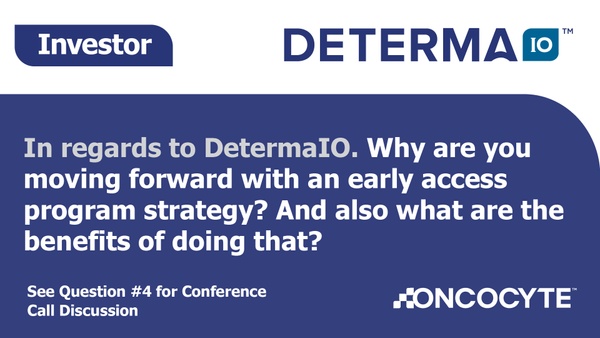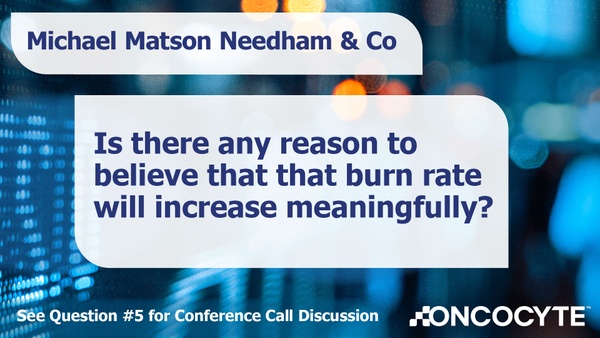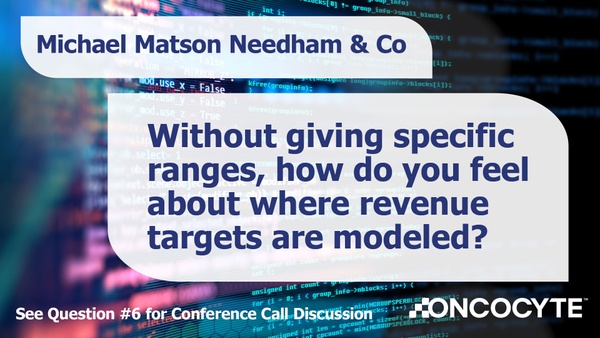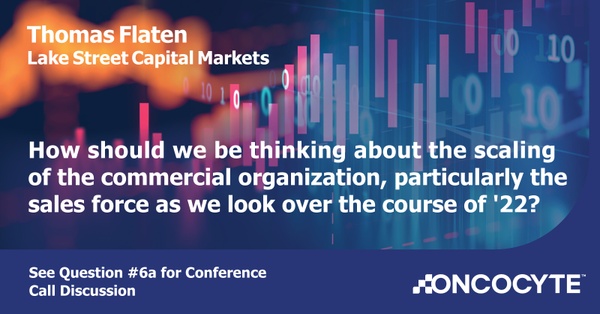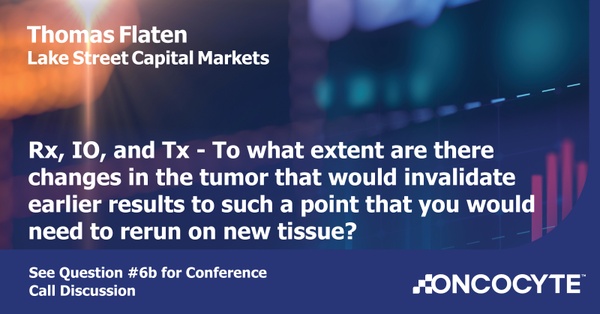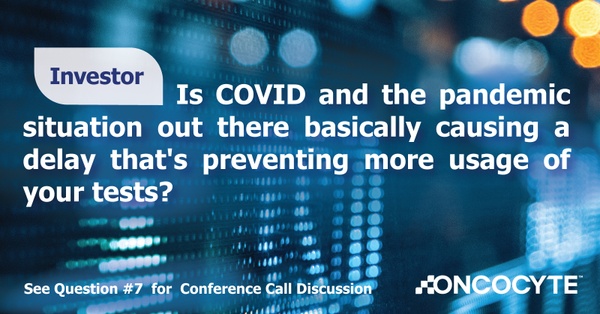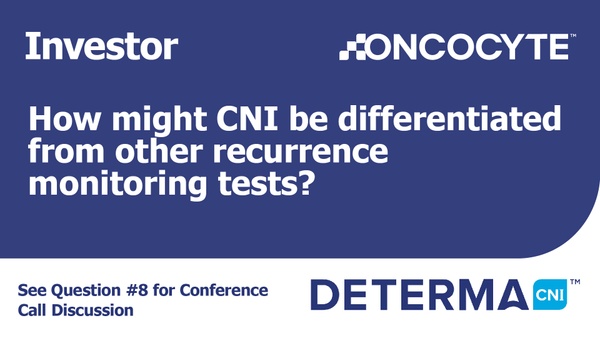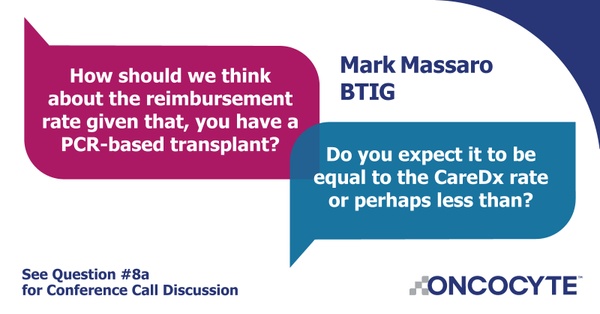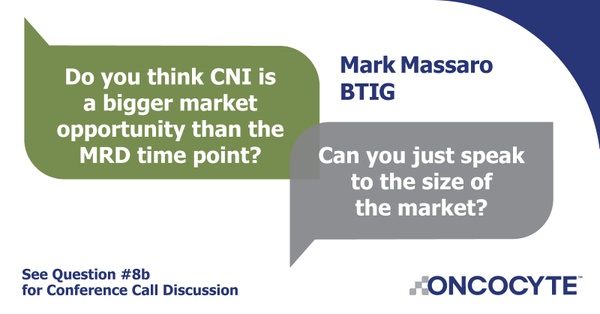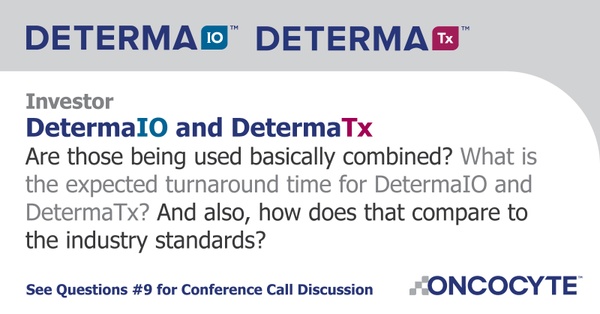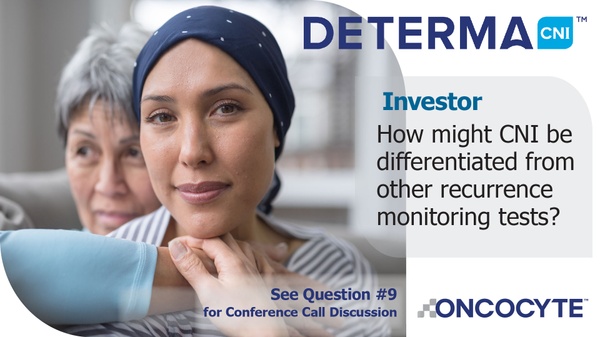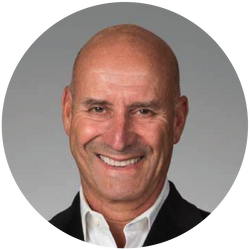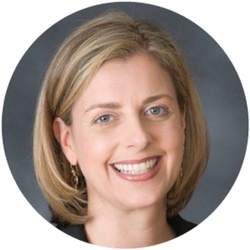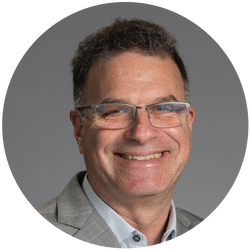
Ronnie Andrews:
Thanks everyone for joining today. Mitch and I were out traveling in the summer and the fall meeting with investors and different groups at different meetings. It became apparent that many of you had questions about a lot of the announcements we're making, how they fit strategically into the overall of the company. And as we got to the fall, it was important for us, we felt, to have a day where we aren't talking about earnings, but we're talking about strategy and the overall product portfolio that we put together here at Oncocyte. Especially, given what we believe is ahead of us in 2022, with a very important year of product launches and milestones that we'll be talking about today. So today's goal is really just to have a little fireside chat, to walk you through the original strategy, how we've done against that strategy, how to make sense of what products fit where, and also talk a little bit today about our newest opportunity in transplant.
And then the goal is to get my talk done in about 20 (minutes) and really open it up for Q&A. It's really about answering your questions today. We want to make sure that every shareholder that is out there has the chance to ask the questions and get the answers that make them understand, and help them know what we're doing and why what we're doing matters across the portfolio. So, Tara, if you'll go to the next slide. Obviously, we are going to be making forward-looking statements today. So I want to make sure that we declare that upfront and it frees us to answer questions in a forward-looking manner regarding strategy and execution. Next slide, please.

Two and a half years ago, I sat on the board and we were at an inflection point in the company where we had a single product that had significant risk to it. And we were trying to find a way, as a company, to mitigate that risk. Given the long history I've had in the industry, we started to look at some unanswered questions that still existed in cancer that we felt like with the advent of technologies that allowed us to look at RNA and really use RNA with DNA to make better decisions or help physicians make better decisions. It became obvious that there were assets out there that had the technology, had tests that had made it through the points of the clinical process to mitigate some of the risk, the clinical risk, mitigate reimbursement risk, mitigate technical risk, et cetera. And we felt like, as a board, that putting some of those companies together under the Oncoyte brand would be the right thing to do. The board asked me to step in and take over the CEO role, which I was happy to do in July of 2019.
And we began the process of acquiring technologies that we believe could answer key questions that were not being answered by large genomic profiling. And keep in mind my history, Dr. Ross' history, Dr. Schwartz's history all is in large scale, genomic profiling. We all believe I think coming out of the genome project, that large-scale genomic profiling would solve all the problems we had in oncology. And what we really did with the large DNA profiling is create a lot more questions as to why this mutation codes in this person and doesn't code in that person? Why does this targeted therapy work in this person and not work in that person? And so the question to answer those questions led us into the world of RNA. And so we had been working for and consulting for companies that had RNA panels that were far enough along in their development cycle that we believed acquiring them would allow us to rapidly build a menu that could answer these key questions.
And so if you look at this slide, the best compliment I've had over the fall was one of our investors said, Ron, you've been showing me this slide for two and a half years. And that's right because this is the strategy we laid out two and a half years ago. We've been very methodical after this to execute this strategy - 2019, '20, and '21, we're all about putting it together, getting the development done, getting these products ready for market. And the exciting part of today's meeting is to talk about all these products now are ready to be in market, which we'll talk about those launches for 2022 in a little bit.

So the first question was, should I give adjuvant chemo? Early-stage cancers today, get surgery but don't really get a lot more than that. There's watchful waiting and we knew that a significant number of patients didn't do well. They recurred, and those patients had a very short five-year life expectancy. We identified those patients using an RNA panel. We launched that product, it was DetermaRx™, and that product has already, in a short 18 months since launch during in a pandemic, we've still been able to save over 600 lives and give people meaningful information that helps them make a decision about chemo that could extend their life expectancy significantly.
The other question that we knew was challenging for the industry from a pure large-scale genomic perspective is should I give immune therapy? I think in the early days we felt like tumor mutational burden, or TMB, would be a winner. And I think what we now know, and looking back retrospectively it is a great prognostic tool and is important in the mix, but is not precise enough to give you an idea of whether that patient will or will not respond.
And so the industry acquiesced to a test called PD-L1, and that's the test that pharma has used. That test also is quite subjective. It has challenges in terms of its predictability and we wanted to do better, and we knew we could do better. And thus having worked with a company called Insight Genetics in Nashville, Tennessee, we knew that there was a product out there that had the ability to identify patients that would and would not respond with precision. And so we made that acquisition in the January of 2020, and we were able to put these two products into play. And that really put us in the market in terms of moving towards treatment decision answers. We added DetermaTx™, which we'll talk about today it's on the horizon. DetermaTx is a product that is today, somewhat some me too in the world, given that large-scale genomics for targeted drugs is out there.
There are companies like Foundation Medicine, Caris, etc. that have a product that answers this question. But it was clear in our market research that if we were going to have a precision to DetermaIO™, immune therapy selector, we should compliment it with a targeted selection panel because that's how medicine is practiced. And this does, a treatment decision menu, does give us the one-stop-shop. And then of course the patient monitoring. We know that majority of these patients don't have a durable response. And so because of that, we felt it was important to follow on with a monitoring assay that could identify very early in the therapy cycle, whether the disease was progressing or not so that we could move treatment to a new protocol and therefore hopefully find the right protocol for the patient sooner than it happens today. And then ultimately use that technology to do a recurrence monitoring assay. Next slide, please.

So all this fits into a clinical cycle, which is described by this slide. And today, as we put the vision together, two and a half years ago, our goal was to make cancer a chronic disease. And we know from watching other deadly diseases, especially in my world, I was very fortunate in my younger years to lead the charge in HIV, viral load monitoring and help take HIV and AIDS to a more of a chronic disorder. And that came by having diagnostics to genotype the virus upfront and then monitoring tools to monitor the efficacy of therapy and change therapy at the point, we knew it wasn't working. And that was how we moved HIV from that deadly disease to a chronic disorder. And so we passionately believe we can do cancer, a trait cancer the same way, and take it to the same endpoint, which is a chronic disorder.
And you can see how our products layout across this patient journey. If it's adjuvant therapy and we can get a tumor resected, then it's early. We want to run Rx to see if chemo is important to save the patient's life. From that we'll run, when Mx is ready for market, we'll look for minimal residual disease. We did the surgery, now is there disease still left in the blood? That's MRD that's a minimal residual disease, that's the utility of that. And there's an MRD test on the market today that is coming out to look at that exact question. Once we see the tumor moved beyond the early stage, now we have to make a bigger decision. Do we give a targeted drug, or do we give an immune drug, or do we give a combination of both? And so this is where IO and Tx fit so nicely.
Today there is either a large genomic panel that tries to answer the targeted question, and there's really nothing other than PD-L1 to try and answer the IO question. And so what we have today and what we have launched is an EAP. And we'll talk more about that and we'll give Padma some... You'll get some core commentary on the early adopter program and how that works later. But the idea here is that IO and Tx in combination within a very short turnaround time, conserving precious tissue, gives a physician, a treating physician, everything they need to know about that patient and the tumor microenvironment at the point when the treatment decision needs to be made the first time. And so within 10 days, we hope to get this information back and that's well within the window of when physicians meet with patients and tumor boards happen for this very critical decision.
But as I said earlier, once we get these drugs, the reality is only about 30 to 35% of the time do we see a durable response. And so, because of that, it's important to monitor these patients. You can't just say, all right, we gave them a drug, six months later we'll do an image and see if it works. Or even do imaging along the way because at the molecular level, you can see changes that are happening before it happens in the image. And so the idea here was to identify a blood-only methodology that did not require a tumor to do a large genome to get to a custom panel as you do with MRD. We wanted to do it in blood only because you don't always have surgical sections at this point in time in the patient's journey. In fact, I would argue the majority of the time at this point in the patient journey, there is no surgery.
These are neoadjuvant patients, which means we're giving them drugs to shrink the tumor so we can do surgery later. Are there late-stage salvage treatments where we're not going to do surgery at all? And so given both of those patient types, you need something that is blood only. Of course, CNI™ is a blood-only assay. You run it periodically. And by the second cycle of therapy, we can give a very predictive understanding of if the disease is progressing not. And of course, if it's progressing, you then go back and look through IO and Tx and other means at the molecular level with large-scale genomic testing. Then what are the resistance triggers that are causing the tumor either to escape using its escape mechanism or is there resistance to the drug itself? So ultimately we want to get this patient all the way to the right, into molecular remission.
And that is our goal. Once we get into molecular remission, that's where our DetermaCx™... I'm sorry, DetermaMx™ product will come in and Mx will allow us to monitor that patient over the out years to see if indeed that patient's tumor is coming back. And so it was important for us, I think today, to lay this out because when you think about why we're doing and how these products fit together, this is the ultimate map of how they fit together. And ultimately, this is how Oncocyte will emerge to manage cancer to a chronic disorder. Next slide, please.
So in order to do that, we have to have precision in both areas of treatment decision and in monitoring. And so, again, high level, this is the complete treatment menu offering. It's a one-lab solution. We answer all the key treatment decisions. Important though, the technologies that we've chosen for each one of these assays use minimal tissue. Now, why is that important? Because traditionally, especially in these later-stage patients, we may get a biopsy. In the lung, it'll be a fine needle biopsy. In some of the other tumor types, you might get a full four, but the reality is there's not typically a lot of tumors to do large-scale testing on. And so for us, it was very important that we not stop. We did not compromise until we found technologies and built tests on those technologies that allowed us to minimize the use of tissue.
So pathologists can do a job that they have to do at the beginning for diagnosis, and we can do our job to compliment them and give them the important information that allows them to make precision-oriented decisions around what therapies to give. Again, two of these tests DetermaRx and DetermaIO are proprietary to Oncocyte. DetermaIO is extremely well-vetted today, as you've seen over the announcements over the last year. We now have over a thousand patients that have been studied across multiple tumor types. So we are very excited about where DetermaIO is going. We are planning on a pan-cancer approach. We'll talk more about how that works as we get to Q&A. And we do believe we'll have an industry-leading turnaround time. The reason I believe we can do that is because the team that we have in operations and especially now with Gisela Paulsen joining us as COO we'll be able to... We believe recreate what we did in our previous lives at another company where we at that point in time had the best turnaround time in the industry.
And we believe those processes and that technology advancement will allow us to continue to do that. Then we move to the monitoring. And so next slide, please. So in the monitoring space, we made a very important acquisition in April, and we acquired a company called Chronix Biomedical. Chronix is a company out of Germany. Dr. Schutz was the founder of that company and obviously now is on as our CTO and an important part of our C-suite, an important part of our team going forward. In this area, it really is about, is the therapy working. We talked about the DetermaCNI, it's blood only. So it's a beautiful application for that question. But in that process, we also acquired some patents that Dr. Schutz had filed around digital PCR and looking for small logarithmic changes in various signals in blood.

And that allows us to at least have a backbone for potentially delivering a product on the backs of that patent state called DetermaMx. Our goal is to start that development in Mx and begin to push that forward late in '22. Obviously, we've got a lot to do in '22. So our initial focus will be on getting the products that are ready for market to market and these others will continue to develop. As the development teams move from development into market launch, we'll be able to move those development teams back and begin some of this important work.
The bottom line is the combined TAMs that we're entering, these are very large markets. And the combined TAM for both therapy, therapeutic treatment decisions is somewhere about five billion in the U.S. and EU. As you can see here, the patient monitoring is somewhere between seven and 10. Obviously, those are not our numbers. We take those numbers from various analysts who cover the space. But the goal is for us to emerge as a one-stop-shop, with a complete continuum of a test that allows physicians to get the answers they need for the questions they still have when they need those questions and when they need our answers. Next slide, please.
So what we want to do is to put it in perspective for everyone. One of the questions we get on the road a lot is, "Wow, you got a lot going on. How have you guys, as such a small company gotten so much done?" And I'll tell you, it's only three things. One, it's the testimony to the mission that we're on and the belief in that mission that our employees have. They're dedicated, they're extremely hardworking, and have made tremendous personal sacrifices throughout the pandemic to continue our product roadmap and continue to push it towards what we believe will be our breakout year in 2022. The second thing is, we have world-class program management. So every project has an owner and we manage those projects on a monthly basis and ebb and flow of the resourcing required.
And thirdly, it's really a testimony to the investors who have come behind us and supported us to make sure we had the funding we needed to move all these things forward in a concurrent fashion. Here, you'll see the milestones for next year, and we wanted to make sure these were available to you as an investor. We're going to put them obviously on our website. This is our scorecard for next year.
So for Rx, it's pretty simple. We want to get the registry up and going and enrolled, and we want to sell a lot next year. The pandemic, we hope is finally going to wind down. Our sales reps will be able to engage and that will be important, very important for us as we enter 2022. The IO and Tx, it's all about full market launch, and it's all about market adoption. We won't have reimbursement for both of these tests throughout the year, so it's really going to be about market adoption.
And making sure we have the right key opinion leaders in the right accounts, ordering and reordering DetermaIO and DetermaTx so that when we do get reimbursement, we already have a run rate of revenue that's ready to kick in. And that's really important for us as it has been for other pioneering companies in this industry, like Genomic Health, like Clariant, like Validation Medicine, etc, who really got ahead of reimbursement by making sure there was adoption and utility in their assays. And so that'll be really, really big for us. Also for DetermaIO and Tx, really important, we believe we're poised and ready to move to the kitting process. We need a platform agreement with a global platform company. So that'll be a very important milestone for us next year because that's how we'll execute our global strategy to get DetermaIO into the hands of folks in Europe, who we know are very eager to see it. Clinical validation, DetermaCNI, we've got work to do to take the data that Ekke and his team in Europe have already created and transfer that here to the US and establish a study path here that leads us to CMS.
So much like we did with DetermaIO in 2020 and 2021, we'll be entering that same phase of market development and paper publications for DetermaCNI as we enter 2022. And then finally, but certainly not least, we are going to launch our transplant business. Our milestones are ready to finalize the LDT. We want to obviously submit the LDT for LCD approval. I think you guys have heard me speak enough to know that that CMS was already given a blanket local coverage decision out of the Palmetto Group in the Southeast for transplant for digital PCR. So our work is to go and prove that we are equal to the technology that was approved for that LCD. We think we will be. We will be definitely because they cited our papers in that LCD. So we have a lot of confidence that we know what we're doing there and we'll be able to drive that. And then ultimately, we need to close a platform relationship because as you'll see, our goal ultimately is to kit the product. So these are the milestones we want to encourage you to keep before you next year. These are the key things that we're going to be doing. We'll be reporting throughout the year, and it'll help you keep these things in content. Next slide.

So now we're going to talk real quick about the transplant opportunity, and then we'll open the floor for questions. So Tara, if you can, just one more slide. So, folks, the transplant market is a very, very unique and interesting opportunity. You can see the number of transplants per year. You can see the number of living recipients. You might think about our business as a monitoring business, much like an HIV viral load, where we're going to be testing patients sequentially or longitudinally over time. And that leads to, at the current reimbursement values for a heart and kidney, that leads to about a $2 billion U.S. market. And so we're very excited about getting into this market. We know there are competitors, they're great companies that are here, but we believe we have a unique opportunity. So Tara, next slide, please.
So our goal for the roadmap is really next year to introduce the company into the transplant market. We're an oncology company, so we need to start establishing our presence there. We are the only company that has a test for liver transplants and liver transplants are a very prominent transplant organ that's transplanted in the United States. So we'll start that and we'll launch in that. We'll focus on that, but we'll also add heart and kidney as the time and opportunity presents itself. Once we get that done in '22, the goal's going to be to establish these partnerships with transplant centers and then ultimately move those centers into our clinical trial phase. So we'll be putting instruments in there, and we'll be putting kits on those instruments. And we'll finish the clinical trial and then ultimately the FDA will give us a clearance of kits, and we'll transition these accounts to an instrument and a kit.
And that'll afford them the attributes that they deem are important. But you can go to the next slide, we'll spend some time on that. So our transplant assay is extremely well-published. Their assurance has been validated in well over 20 publications. These are not small publications. These are all very prominent journals, peer-reviewed journals. And so you can see here that we have four major patents, and we're the only company today with a product indication in liver, which we believe is a very important organ that really needs our test to help patients with that organ to get the best outcome. Next slide, please.
And our go-to-market strategy is pretty simple. Phase one is the EU launch. So we have a partner meeting in Europe. We're obviously looking for a partner in Southern Europe. I would hope to find that partner in the first half of '22. And we are going to be filing for reimbursement in chosen EU countries. We already have a head start thanks to Ekke his team in Germany. In the U.S., transfer the LDT from Germany to Nashville, which is underway. Launch the LDT in the first half, apply for reimbursement and establish the clinical trial network. What we'll do is start the clinical trial, and we'll begin to engage sites in the second half of next year with the idea to complete the clinical trial phase by Q1 of '23. And hopefully submit the FDA dossier in the first half of '23, as well as submit for the new regulatory approval in Europe, which is called IVDR. And then obviously once the kits are launched, we'll expand the market presence by beginning to place a footprint of instruments across the market. Next slide, please.
So let's go to the 2022 outlook. Again, we want to share with you our thoughts on where we're going and what all is going to happen next year so you can keep things in context as announcements happen and you see us move forward. So next slide please, Tara.

So this is the product development timeline. We get asked a lot of questions about where we are at certain timelines. And so what I thought I'd do is put a slide together to give everyone an idea of the various phases of getting a product we make to market. This slide will obviously be on our website afterward, and you can kind of spend some time with it. You can see DetermaRx is already at the revenue stage and on the market. You can see DetermaIO. We are in the EAP launch phase, which is where you have market development phase. And we will be submitting the reimbursement dossier by the end of Q2, 2022. You can see DetermaTx is in its clinical validation. It is a predicate market, so what does that mean? There are other tests out there already with this indication, and there's already reimbursement for these types of tests.
So for us, we want to get IO on the market in that cadence and then follow it with Tx. And so Tx can catch up very rapidly once we launch it in terms of when it gets reimbursed. We do think that Tx, between IO and Tx, we're the first test out there to get reimbursed with those two. Obviously, DetermaCNI is launched in the EU as an RUO product. And we'll be bringing it here and starting this mark development in the US in the second half of 2022. Well, transfer it in the first half, and then again, hopefully in the second half with some studies and trials. And of course TheraSure we mentioned already our goal is to really rapidly bring this product to market. So if you think about 2022... Tara, if we go to the next slide.
This slide is really our anticipated revenue initiation phase. And so you'll see here, we put this slide together. We took the previous slide. We looked at our product development timeline. And we started to say, all right, here's when we think given what we know today about CMS and how it works, this is when we expect to start seeing revenue from these products. So we're going to launch these products as we talked about earlier, pre-revenue. But once we get the LCD approved and pricing is given we'll then move, and we'll be able to start recognizing revenues on these products. So real important, Rx obviously is already on the market, but we just got the Burning Rock, as you saw, milestone met. So we're expecting Burning Rock to bring the test up and, and launch it in the January timeframe for China. Obviously, when that happens, we'll be receiving a royalty trail for the work that Burning Rock will be doing in China.
You can see TheraSure we expect to have reimbursement for kidney and heart in the second half of '22. As well as we expect to have DetermaTx reimbursement in the US in the second half of '22. And then in the first half of '23, we'll see the reimbursement for IO. We'll submit that as you saw in the previous slide in the first half of '22. So given the current CMS cycle, we expect to have revenue generation out of that in the first half of 2023. And then you can see we'll launch clinical trial launches and CNI will actually be in the market and hopefully generating some clinical trial revenue by the first half of 2023. So I think the important thing to note if you go to the next slide, Tara, is that, and the important, I thought, part of today was to really just have a discussion with investors about what we came here to do two and a half years ago. And actually what we've been able to do.
2019 and 2020 were really all about acquiring the technology and platforms, getting the test and integrating the companies, getting through the clinical development phases, and poising it ready for market. '21 was to launch DetermaRx, which we did, and then continue the development of the portfolio as well as acquire and get us into liquid-based technology, which we were able to do. All of that got done despite the pandemic. And so here we sit in '22, ready to do an important part of our mission, that's drive market demand. Next year is all about driving market demand for all of our products. We'll be launching three products across oncology and transplant, and it's important next year that we begin to drive market demand, as well as submit on time for reimbursement. And then we want to aggressively go after a platform partnership because global expansion DetermaIO is extremely important as is our ability to get transplant.
And then obviously '23 is all about exponential revenue growth. And so '23 and beyond we, we expect to see the final culmination of all the work that's going on from the Oncocyte team and the investment that's been made in Oncocyte to date. This is something we've been working for since the beginning. And I'm just proud to say that the team's done a lot over the last two and a half years. We've made major progress across every product over that time. And despite the market swirl, we believe that we've never been in a better position to go and achieve the market value and the revenue ramp that we had expected from the beginning when we started the strategy before now. '22 is a coming-out year for these products, in '23, once everything's reimbursed there'll be the revenue benefit of all that hard work. So thank you for your time.
I'm going to ask Tara to let us move to Q&A now, and we'll take questions. I encourage you to ask whatever question you feel that you didn't get answered during the presentation. So, Tara, you want to take it over from here?
Tara/Moderator:
Yes. Thank you, Ronnie. At this time, we'll be conducting a question and answer session. If you would like to submit a question you may do so by using the Q&A text box at the bottom of the webcast player, or by emailing your questions to questions@lifesciadvisors.com. And to our analysts, I now invite you to join via Zoom. Please hold for a brief moment while we hold for questions.

Ronnie Andrews:
Tara, while you hold for questions and take down the slide, I want to introduce the team that's here with me today. So first I'd like to introduce Gisela Paulsen. Gisela is our newest member of the team and a great addition. Gisela is our Chief Operating Officer. I'm going across the top of my screen, so Ekke Schutz. Dr. Schutz is our Chief Technology Officer, and also the GM of our European GmbH business. And Padma Sundar, of course, is our Chief Commercial Officer. And Mitch Levine is our Chief Financial Officer. And last but certainly not least is Dr. Doug Ross, who is our Chief Science Officer and acting Chief Medical Officer. So you got what I like to call the dream team on the call today. And I'm going to hopefully not have to say much more. We're going to try to let your questions go to the appropriate expert and get you what you need to feel good about where Oncocyte is headed in 2022.
Tara/Moderator:
Thanks, Ronnie. So our first question comes from Mark Massaro from BTIG. Mark, you may go ahead and unmute your line.
Mark Massaro:
Hey guys, can you hear me?
Ronnie Andrews:
We can.
Mark Massaro:
Great. Well, thanks for that nice presentation. Lots going on. I guess the first one is cut and dry. Have you heard anything from NCCN with respect to DetermaRx?
Ronnie Andrews:
We have Mark. I'm going to let Doug answer that he was on point for that. So, Dr. Ross, do you want to give the update?
Dr. Doug Ross:
Yeah. So in fact, the NCCN did update the non-small cell lung cancer guidelines last week. Unfortunately, we were not part of the very small group that got the nod and was included in the NCCN guidelines. It'd be insincere to say we weren't disappointed because we believe in the test. We believe that we're actually improving outcomes for patients, for the folks that use the test. It was an early submission. I'll remind you that the definitive paper came out in June and the committee met in July. So the amount of awareness of the test and so forth amongst the community was probably modest at the time. And so we were hopeful because we think it is an incredibly important application that really does improve lives.
But we're continuing to produce data. I think as Ronnie's been clear, we're doing a registry that's going to add to the database around it, the amount of awareness. Now, since that publication's come out, the amount of awareness about the test is really to Padma's credit, with all the commercial effort that's gone behind it, people now know about it. And so although we were disappointed and not included, we still think it's very important and with the added data, the added awareness we'll also be submitting to other guideline organizations that are on a different cadence, and so forth. So yeah, we did hear, but we're not discouraged by it.
Ronnie Andrews:
And Mark, I think you know as well as anyone that the pioneering predecessor's companies like Genomic Health and the Foundation and those guys, they paved the way for us. So it took them three or four cycles to get that NCCN. We're still hopeful it won't take us three or four cycles because of the awareness that they create. But you know, we're disappointed, but we're not going to be deterred from growing this business.
Padma Sundar:
So Mark, like other companies, we are continuing to grow Rx volumes and will continue to grow that. And to Doug's point, there are other respected guidelines that we can pursue, lung-specific guidelines even, so that's that avenue. And as there's greater awareness, thanks to the registry, which is a multi-center registry, that'll give us another shot to go back with more third-party data, if you will.
Mark Massaro:
Excellent. Thanks for that update. Sorry to hear you didn't get in, I guess, maybe for Doug, can you maybe expand a little bit on the other data development for Rx? Now I think as people try to think about getting into NCCN next year, just remind us, I believe NCCN meets annually? So, is it right to think that by July 2022, you'll be eligible for inclusion again? And do you think you'll have additional data or publications to submit to NCCN that would potentially warrant inclusion next year?
Dr. Doug Ross:
Yeah. So I think that there are really a couple of things that go into NCCN. I don't know if you know much about the process, but it's kind of a group dynamic. There's a large number of folks that meet. They have a large number of stuff in front of them. And so, the gist of getting into NCCN guidelines is to have somebody who's really carrying your ball as well as to have enough awareness in the community that it's not new to people. That this is something that they feel like patients should have access to. As I said, in our key publication, the 250 patient paper showed that high-risk patients, when they're identified as high risk and they take adjuvant chemotherapy have a less than 5% recurrence rate.
And those folks that choose not to take adjuvant chemotherapy in that study had about a 30 to 40% recurrence rate. That's the impactful paper that really just came out in the weeks before that. And so we are continuing to generate data. Unfortunately, there are no cohorts that we can do retrospectively to do that. Those cohorts are over 20 years old and the RNA is not available for them. So the registry that Padma has been driving has really exposed the test and the value of the test. Both to thought leaders, and especially to the large networks of community oncologists who are struggling with the decision as to whether or not they treat with adjuvant chemotherapy.
So I think a combination of that paper now being out, it's been talked about at meetings and the amount of awareness that we've driven both among thought leaders in the community through the registry, hopefully, will put us up to bat. As well as, the dynamic is different from some of these others... As Padma Mentioned, ASCO has respected guidelines, there are European guidelines that are respected. And the feedback that we're getting is that people want access to the test. And that drives the momentum that hopefully we'll get included.
Ronnie Andrews:
Yeah, sorry, Doug. Our initial papers were a single site and obviously with one of these we want to do is add multi-site. So the registry gets us the multiple site data as well. So more to come on all that but good question. And obviously, we know the test is saving people's lives, so we're not going to slow down in our efforts.
Mark Massaro:
Okay. On the new product launches, I think on the Q3 call, you talked about launches of CNI and Tx in Q1. Today, you talked about the first half, I'm just trying to gauge if there's any change since your Q3 call or if this is really just a function of semantics.
Ronnie Andrews:
Yeah. It's a function of semantics. We frame the first half, second half internally because we're trying, as you might imagine, we're juggling multiple priorities, Mark. And one of the beauties of Gisela joining is we now have someone who is acutely adept at bringing multiple products through and making sure they stay on track from her experience at Genentech as well as Genomic Health. And so what we want to do is we have to make decisions like, for instance, we made a decision stand up transplant with the same team that was tech transferring CNI. So we had to pick one, so transplant took precedent, but as soon as that LDT is up and going, CNI will come in and we'll get the tech transferred. So we still expect we can get it all done in Q1 of next year, by the end of Q1.
Mark Massaro:
Okay. Moving to DetermaTx, I believe that you've chosen a panel from a large tools company, a 500 gene tissue panel. My understanding is that... You talked about it. Therapy selection panels are widely broadly reimbursed. Remind me what's proprietary to DetermaTx relative to what is already being reimbursed by that panel provider. And walk me through why you need to secure your own reimbursement when frankly, my understanding is that panels are already reimbursed.
Ronnie Andrews:
Yeah. It's, it's really semantics, Mark. You're absolutely right. And our panel will fit under the current LCD that's written. But Padma is our market access expert and Padma, do you want us to add some color commentary on what we have to do to check the box?
Padma Sundar:
Yeah. It's very simple. It's already covered under the LCD. So what we need to do is show concordance against an already approved test and then we get paid. That's the only step we need to do, so no studies. And that's the standard step, which is called tech assessment.
Dr. Doug Ross:
Yeah. If I could just step in and just address the differentiator. So the key clinical problem here for non-small cell lung cancers is in late-stage lung cancer, you get a tiny, tiny specimen. And so we've selected a technology that's incredibly efficient for delivering both the targeting information, what you call the standard type information of a targeting test, as well as enough to deliver the immune-oncology, DetermaIO information. And so as well as candidly, we hired one of the best guys in the business that has some proprietary tricks. And so our QNS rate is going to be much lower, I strongly believe that. So it is differentiated, but it's behind the screen, it's not in the content that's on the test which most tests are complete at this point.
Mark Massaro:
Excellent. One more question from me and I'll hop back in the queue. I believe it was Palmetto MolDX that came out with a final LCD, an umbrella LCD for MRV testing, which I believe was in November last month. I believe it goes live on December 26th, and one of the tests included is the Netra Signatera IO test. Can you just walk me through how you're thinking about whether or not you think you can get your IO tests to fall into that umbrella LCD and then when will you know that? What steps are you taking to see if that's the right path?
Ronnie Andrews:
Yeah, let me frame it and then Padma, I think if you and Doug want to add some color commentary. First, we were very excited to see that blanket LCD, because I think it gives us an idea of what we've got to do to prove DetermaCNI as an effective monitory tool of therapeutic efficacy. And so it did give us a framework Mark, which we are glad to have because as we bring CNI to the US it'll help us. Ekke's way ahead of us in the US, we've now got over 1,4400 patients under study across multiple tumor types in Europe for the term CNI. So that work will produce papers that we hope to have out in the fall. But I'll let Padma chime in on the actual tactical execution of getting to a point where we can actually submit.
Padma Sundar:
One thing I would like to clarify is, although the LCD is labeled MRD it is important to know that it covers much more than MRD. It covers monitoring. So it is possible for a test to take advantage of that LCD, by being a monitoring test. You don't have to be an MRD test. And that's where CNI is well-positioned to be under that blanket LCD. So what do we need to do? Since that blanket LCD came out, we've done an assessment of the studies that we have. We do have one in immunotherapy study, and we have several others that are ongoing in Europe, which we are able to modify in short order to make sure that those endpoints are the exact endpoints that the LCD is looking for. So Ekke and their team are driving those studies out of Europe. And we believe that with the published study we already have immunotherapy monitoring, plus those additional studies that are ongoing now, we'll be in a good position to take advantage of that LCD.
Mark Massaro:
Okay, terrific. I'll stop there and hop back in the queue. Thanks.
Ronnie Andrews:
Thanks, Mark. Thanks for the questions. Bob, any questions from the internet that we should entertain?
Bob:
We do have a few questions here. The first one is, why are you moving... This is with regards to DetermaIO. Why are you moving forward with an early access program strategy? And also what are the benefits of doing that?
Ronnie Andrews:
Okay, Padma, I'm going to put you on the spot. I think it's a commercial tactic that we've both employed throughout our careers. And that is to get a small subset of key opinion leaders and friends of the company to kick the tires, if you will, to make sure we establish protocols workflows and touch all the bases from a compliance perspective in the lab world. But from a commercial perspective, Padma, why don't you add some color to the importance of the EAP before full market launch?
Padma Sundar:
Yeah, I'd like to say, this is my seventh product launch and this has always been very effective launching via an EAP. So it accomplishes two things. One is, as we've talked about it, this is a tissue-based test and this is a test that needs to be turned around rapidly. So what the EAP allows us to do with friendly customers, we've selected seven, who already are users of the test because they have experience with DetermaRx to make sure that we'd 100% beat/meet expectations in terms of how little tissue we need and how fast we can turn it around. We are targeting three to five business days from the day sample is received. So that's the number one.
Second is we validated the test in four different cancers now. And in my experience, when you let oncologists have access to the test, they find additional use cases that the company could have not thought of because they are the ones in front of the patients and they find use cases for the test. And that's exactly what happened in my prior life. So for those reasons, we are doing it as an EAP, but of course, once we have DetermaTx and we have that complete one-stop solution, every plan is to go national and make it accessible to all oncologists who want to use the test.
Bob:
Okay. That's great. Thanks, Padma. The other question maybe is more of a financial one. This is from an investor at American Portfolio, which is, basically, believes that there are rumors about a potential dilution of the company's stock. And I guess Mitch, that really goes to, is the planning, is the company planning right now on basically issuing additional shares?
Mitch Levine:
And yeah, thanks, Bob. No, we don't have any plan to raise additional capital at this price. At the end of the third quarter, we had about $43 million in cash. Our cash burn was higher in Q3 as we ramped trials and hired expert personnel to execute. We expect that that was our high watermark in cash burn and think that we have ample cash at this point.
Bob:
That's great.
Ronnie Andrews:
It's important for shareholders to remember that we have revenue streams. We have certain licensing agreements. We have other ways to create that are non-dilutive and we pursue those every day. And we don't typically make a big deal about those, but Mitch has done a really good job, making sure that the balance sheet stays healthy and we have the money we need to go execute. And obviously pushing towards reimbursement and revenue is the ultimate goal and the thing that's on our mind every day, so that we eliminate the fear of dilution by selling more and more products.
Bob:
Great. Okay. Good. I think I'm going to turn it back to Tara.
Tara/Moderator:
Great. Thanks, Bob. Our next question comes from Mike Matson from Needham. Mike, you can unmute your line.
Mike Matson:
Hi, can you guys hear me?
Ronnie Andrews:
Yeah, we can. Hey Mike.
Mike Matson:
Hi. So I wanted to follow up on the cash question that you just answered. So, it looks like you're burning about nine to 10 million a quarter in the current year, 2021, you have about 45 million or so in cash at the end of the third quarter, just given that you are expanding your initiatives that you're pursuing here with TheraSure and whatnot, is there any reason to believe that that burn rate would increase meaningfully?
Ronnie Andrews:
Yeah, no, Mike, I think the idea is that TheraSure is an asset that has value. We don't believe that asset has been even calculated into the current stock value. And we know there's a lot of people, partners, potential partners that are interested in that asset in terms of a partnership. And there are different ways that partnership can go. And certainly, we think there are ways to get TheraSure funded and get that business up and going that would be minimal dilution to shareholders given the partners that are at the table. I can't say a whole lot more than that, but our goal obviously is to make sure that we get TheraSure to market and get revenue. That's our fastest path. The significant revenue right now is in transplant until IO is through the reimbursement phase.
Ronnie Andrews:
And so it for us, we're acutely aware of that. And the good news is given the US patent office's acknowledgment of our patent state in the fall, and given the fact that the LCD already exists for digital PCR and our method was cited, we're fairly bullish on our ability to bring this up and to start generating revenue. It's a very concentrated market, as you know. So there's about, I think I heard the other day there are 80 accounts, I think that make up about 85% of the total volume. And obviously, many of those accounts would be very interested in having liver because those are the large liver centers and today there's no solution for liver. So we think our strategy will reap some benefits and obviously more to come as we get through the first quarter.
But that's, that's the plan is to leverage that asset and drive as much value from that asset as we can while concurrently, we go to market and get these oncology... Amazing oncology tests into the market and obviously creating volumes. So when they get reimbursed, you get not just a slow takeoff of revenue, you actually get this sort of hockey stick that happens, because you've got multiple tests that are now already seeing volume and now have reimbursement.
Mike Matson:
Okay, great. And that's actually a good lead-in to my next question, which is, and I know the purpose of this call is not to give guidance for 2022 or anything like that. And I know you don't even really give any kind of revenue targets, but it does look like consensus has around 17 million or so give or take of revenue for next year. It looks like it's pretty back half weighted to the second half of the year, roughly 5 million in the first half. Which isn't all that different from the runway you've been on, but then that increases to about 11 million in the second half. Just given your slide there, it looks like you're expecting revenue to start from DetermaTx and TheraSure sort of midyear, is that right? And how do you feel, without giving specific ranges, how do you feel about where things are modeled? My takeaway is that the numbers might be a little on the high side, but I don't know if you can comment on that at all.
Ronnie Andrews:
Yeah, let me say this and Mitch is in the room to kick the shin, but I'll say it since we have such a large group of investors. Those numbers, our numbers next year are really predicated on the execution of bringing these tests up and getting the LCD file or the submission and getting approval for Tx and for transplant. They're both, in the world I see today, and Padma and I talk a lot about this, in the world we see today, we certainly believe the second half of 2022 is viable for transplant reimbursement approval as well as Tx. If those happen on time then...
And the good news is as we get into the year, we'll be able to time it more and more, Mike, on where we'll end up. Right now, we are assuming based on our knowledge of Medicare and where they've been in the past, that our swag, if you will, as to when that's going to happen is real. But we'll know more as we meet with them in the first quarter and see where they are in the backlog, etc. But right now it's too hard to comment on that number, whether it's too high or too low until we know if we're going to have the transplant and Tx reimbursement.
Mike Matson:
Okay. Understand, thank you. And then I want to ask one about just given the update on Burning Rock, the recent update. Maybe you can comment on your latest thoughts around that launch of DetermaRx in China and what's happening from a COVID perspective over there? Are you going to see similar kinds of limitations to adoption that's happened here because of COVID?
Ronnie Andrews:
Mitch has been on point and done a terrific job with the relationship. I'll answer the high-level market question and let Mitch talk a little more specifically about Burning Rock. We do see obviously the pandemic has hit China as well and what we're hearing or what I'm hearing at least from colleagues that are operating in that market is it's similar to what's going on here. However, just because of the sheer number of people with early-stage lung cancer in China, I think that Burning Rock has a nice footprint.
They have a very great reputation and it's very... We believe that they'll be in the market in Q1 and they'll be generating revenue from that test. There's about, I think Mitch, they said about 100,000 served market opportunities a year right now, based on their knowledge. So, if they get out there and get going after it we should see royalty payments from them throughout the year. So Mitch, anything specific to the relationship and what they've heard from Burning Rock?
Mitch Levine:
Thanks, Ronnie. So you're right. They have about 100,000 total addressable markets there. We believe Burning Rock has 60 salespeople. They've already begun commercialization and they're getting a lot of attention. And so we've been able to do our full tech transfer. They have everything in their possession to satisfy the tech transfer. We've pushed out one of the milestones, a couple of months just in the spirit of the collaboration with Burning Rock and all systems go is there. They're very enthusiastic about their prospects with DetermaRx.
Mike Matson:
Okay. Got it. Thank you. I'll let some others jump on.
Mitch:
Thanks Mike.
Ronnie Andrews:
Bob, any...
Bob:
Yeah, Tara. Yeah, we do have some other questions from the... Coming in from the internet from investors. One of the questions is, they're asking about CNI how that might be differentiated from other recurrence monitoring tests.
Ronnie Andrews:
Yeah. Doug, I think you obviously have a really good handle and so does Ekke. Ekke are you... I don't see Ekke but he may not be on my screen. Ekke if you're on, why don't you take that question? Maybe give some insight as to your vision... Oh, there he is. The vision behind CNI and a little bit about how you see it fitting in compared to MRD.
Ekke Schutz:
Yeah. Thank you. One main differentiator that we have with CNI is that we don't need any tumor tissues. So it's really something that we can do from each and every blood sample we get, which is inherent in the technology that we are using here. And we really have focused on the monitoring aspect of treatment, not that much on MRD. So I think the major differentiator here is really that we are pretty confident that it's a test that we can well use for therapy, pre-monitoring of advanced cancers to look at the question does the therapy really works. And in that point, we are adding a pretty high predictive value to detect that therapy is going to fail. That's more or less what the differentiation is against other tests that are more focused on MRD rather than direct therapy monitoring.
Ronnie Andrews:
Yeah. And our real claim to fame, Ekke is, you and I looked at this market together, is that the time to first result, time to really know something, is at the second cycle of treatment for CNI, DetermaCNI versus a few weeks later for MRD. Because it takes time to get the large panel completed and then the custom panel developed and then validated in the lab, et cetera, et cetera. I think the other thing for investors to note too, is that, as Doug so appropriately has educated me about adjuvant versus neoadjuvant versus late stage is that... And Doug, you can comment on this.
MRD is really for resected tumor and to monitor, did we get all the tumor? And that's not what we're looking at with CNI. We're actually looking at a different measurement, which allows us to run patients that have either had surgery or also patients that haven't had surgery. And the vast majority of stage three to four patients, Doug, don't get surgery first. They either get neoadjuvant to shrink it and then. So maybe a comment about that and how we believe we can really provide more testing for more patients.
Dr. Doug Ross:
Yeah. All the excitement in the market has been on the MRD application. Can you find any circulating tumor DNA after you take the tumor out? That's really quite different than what we're trying to do. The therapeutic monitoring application that CNI is really perfectly suited for is you have a lot of tumor load. You may or may not be able to get a hold of the tumor sample. And you want to ask the question in the first couple of cycles of therapy, is it working? And so the advantage of the CNI test is that it integrates information all the way across the genome into an index that says, Hey, the tumor's either getting worse or it's getting better. And it's exactly the appropriate test for that application. And it's not MRD, which is where all the noise has been. It's a very different clinical application and a very important clinical application that hasn't been adequately addressed yet. So, that's how I see the difference.
Bob:
Great. Doug. I'm going to turn it back to Tara because I know we have some other analysts here with some questions.
Tara/Moderator:
Thanks, Bob. Our next question comes from Bruce Jackson from Benchmark. Bruce. Go ahead.
Bruce Jackson:
Thank you. And thank you for hosting the webcast. I have a question about DetermaIO. Ronnie, you did a very nice job of going through the history of tumor mutational burden and PD-L1 testing and how DetermaIO has overcome a lot of the limitations of those tests. The question about the future, there are a number of companies working on new discovery platforms with proteomics. And I wanted to know how you think DetermaIO is going to hold up in the future marketplace when some of these platforms get out of discovery and into the clinic? And if there are any opportunities to you for you to work with those platforms, or if you might... Where do you think DetermaIO is going to fit into the future market?
Ronnie Andrews:
That's a great question, Bruce. I'm going to let Doug take you through the deep science, but I'm going to answer that last question. As you know, we're always out there looking, we're always doing surveillance of what technologies are out there. Is there anything that could complement this? Some of our European colleagues and our investigators in Europe are working on things like spatial recognition and things like that. And so those things are years away, but as they become tools that amplify and create more fidelity for DetermaIO, we'd certainly try to adopt those. But right now, given how we reduced 2,000 genes to this 27 gene classifier, we actually have relevant RNAs from the key components of tissue, microenvironment. And Doug maybe, as you think about the competition and you're on the front lines with all these investigators, what are they so excited about and why do we think we have longevity with DetermaIO?
Dr. Doug Ross:
Yeah, so I first want to break proteomics into two fractions. There are folks that are looking for signatures in blood, that have the challenge. It's very removed from the tumor tissue where all the action is. So I think those, from a point of view of prediction, are a long way from market. But what is interesting, at least scientifically interesting, are folks that are doing complex image analysis of tumor tissue and identifying all the different cell types that are in there. And trying to do perhaps single-cell genomics and things of that sort. That is really cool science and I love it. I love to read it. But it's very challenging to practically translate that into a clinical diagnostic.
A clinical diagnostic has to be a good classifier and it's all dependent upon the sampling of the tumor, stochastic sampling problems. And if you're looking at the spatial distribution of cells in a complex tumor, you require a tremendous amount of training data to get at that right. So I think those platforms have a challenge getting to market. We've already shown that DetermaIO is really a spectacular classifier. I'm a pathologist and classification is key here. And that classification serves it well, which is why we've gotten such great results as we go from tumor type to tumor type. So, there will be competition, but I like the way we've approached this better than the spatial proteomics approach. I think those are interesting, but challenging to get to market.
Bruce Jackson:
And then just a quick follow-up question, would you care to hazard a guess as to how many years of a head start you have with those products?
Dr. Doug Ross:
Yeah, absolutely. Ronnie could probably answer that as well, but we've got a large number of studies under our belt in four different tumor types. It's the same algorithm, the same threshold. That's what surprises the thought leaders that we talk to. That's not true for PD-L1. It's not true for TMB. It sure as heck is not true for counting CD8 cells in a tissue. So we have a lot of data. It's coming to market. We've got thought leaders behind us. I'm enthusiastic and optimistic. Ronnie?
Ronnie Andrews:
I'm going to be more... This is usually... Doug's usually my counterbalance, but I'm going to be his. Listen, Bruce, I actually think one of the things as a sort of David in the Goliath world, most of my career, and having slain that giant a few times already, you never discount the potential competitor's ability. So that means we have to respect it and we have to constantly look at it. Which I know Doug does and I do and Ekke. Having Ekke on board now is really exceptional because he's in Europe. And a lot of these technologies are on the front lines. Europe has a little softer regulatory approach than we do in the United States. So a lot of the things get to market faster in Europe than they do in the United States.
And so having Ekke there as a forward scout allows us as well. Plus Ekke, his historical prowess has been in blood-based rare events and being able to identify rare events in blood and cross transplant and cancer. And so I feel like we know what's out there and I feel that we're at least two to three years ahead of everyone just given the clinical path that they've got to get through to establish enough data to support the types of claims that we already have. So, I don't want to be cocky, but I do think, we have a nice head start in the world of tissue microbiome.
Bruce Jackson:
All right. That's perfect. That's all I've got for right now. Thank you very much for hosting the event and thank you for taking my question.
Ronnie Andrews:
Absolutely. Thank you, Bruce, as always. Tara, are there any more analysts that you that would like to ask questions?
Tara/Moderator:
Yes, we have Thomas Flatten from Lake Street. I'm pulling him in right now.
Ronnie Andrews:
Okay.
Tara:
Thomas, you may go ahead and unmute your line.
Thomas Flatten:
Hey guys. Thanks for taking the questions. One for Padma, as you think about IO and Tx launching and some of the early successes with IO in the early access program, how should we be thinking about the scaling of the commercial organization, particularly the sales force as we look over the course of '22?
Padma Sundar:
Can I go, Ronnie? Yeah. So obviously the reps that we have now that are 10, we always intended for them to not just sell Rx, but to sell IO because they are calling on the same call point, the lung oncologist. And in the community clinics, they have easy access to the other tumor types. Right now, to support the EAP launch, we are thinking of, we are going to be adding three salespeople in three states where we have the highest total addressable market. And then going into the national launch along with Tx, we'll make an additional headcount in the sales team. So we expect to end the year with about 20 reps.
Thomas Flatten:
Got it. And Ronnie, I hope I didn't mishear you at the very end of your prepared comments, you mentioned the importance of a global IO launch. I think I heard that, right? Can you just frame up for us a little bit, the distribution of the... Very expensive therapies are obviously very skewed by the wealth of countries. So could you maybe give us a sense of when you say global launch, I'm assuming that's a smaller number of countries than there are out there. Could you just help us think about that opportunity a little bit?
Ronnie Andrews:
Absolutely. Yeah. When we speak of the rest of the world or global, we actually think in three buckets. We think of the countries in Europe I like to call the FIGUS countries, which are, France, Italy, Germany, the UK, and Spain. They are typically the ones that get out first. I particularly had a lot of success in my career in Germany first, then Italy. They seem to be progressive, but very thoughtful about the value-based medicine they practice. As you might imagine, a lot of our tests save a lot of money from drugs that are overused. And so, as you might imagine, IO is a very... It's a very big difference in Europe where there's value-based where we don't want to give the drug unless we know it's going to work versus the US, let's give it to everybody and hope it works.
Ronnie Andrews:
And so right now, I think you've seen the numbers that I see, $125 billion spent in immunotherapy 2025, $70 billion is predicted to have no impact on the patient. And so Europe's ahead of that game. And so we know some countries are interested more from a health economics perspective. And so Germany's being one of those. And with Ekke and his network there, we hope to get there quickly.
We can't serve Europe with a lab and we learned the hard way. I learned the hard way at Clariant. I think my colleague, Mike [inaudible 01:07:14] learned the hard way at Foundation Medicine. I think my friends at Genomic Health learned the hard way. It's very difficult to build a lab and run it from a central country in Europe. You almost have to build a lab in every country. So our fastest path to penetrate Europe, we believe is a kit on a platform that already has a solid install base. And so that's the goal and that's what we've been working towards.
Thomas Flatten:
Got it. And there's one final one in one of your earlier slides, Ronnie talking about Rx, IO, and Tx one of the selling features, so to speak, of your approach is the need to have a relatively small amount of tissue. If you think about an earlier stage adjuvant patient, there might be a significant time lag between when they need to be re-challenged with a new drug, for example. To what extent are there changes in the tumor that would invalidate earlier results that you might have run at the time where the tumor microenvironments changed to such a point that you would need to rerun on new tissue?
Ronnie Andrews:
You know what, Tom, that's a very powerful and important question that the industry has yet to acknowledge. And I'll give you my opinion, but Dr. Ross and Dr. Schutz should chime in as MDs. As from my role at ASCO, I hear a lot that people are afraid to re-biopsy patients. They don't need to, it's the same tumor, but that's just not what's happening in the real-life of molecular profiling. And I would argue that over time as therapy is given and fails, that re-biopsying when you can, you can't always do a biopsy but if you can, and then getting a fresh biopsy always gives us the best chance at treating the actual tumor that's that taking the patient to a bad place at that moment. And Doug, any comments? Ekke, any comments on my comment? I don't want to practice medicine because I'm not smart enough to do that, but that's what I see and hear from my colleagues. So Doug?
Dr. Doug Ross:
Just a quick comment that some of our data is from metastatic sites and from biopsies taken late during the course, and it holds up. That's very promising and the rationale behind that is that in fact, we are classifying the biology of the tumor and really its effect on the tumor microenvironment around that. And that's a function of the tumor that doesn't change unless it becomes resistant unless it's seen immunotherapy before. So I'm optimistic that it'll be good.
Ronnie Andrews:
The combination, Thomas, of IO and CNI without a doubt will be an effective game-changer. We'll be able to see if the disease progressing. If it is then there's probably this transition in play. The tumor's trying to escape and you might want to think of another therapeutic approach that's a little more aggressive than a monotherapy. Maybe it's a combo, maybe it's chemo, maybe it's a target. But that's all played itself out in the pharma community. And the beauty is we have a test that's robust enough to cross all those decisions.
Thomas Flatten:
Great. Appreciate you guys taking the questions. Thanks so much.
Ronnie Andrews:
Of course, Tom. Thanks. Okay, Tara, let's let Bob... Bob, any other email questions that we should answer?
Bob:
Yeah, definitely. We have a couple here. The first one was from Ben Turditch. Ben asked, how do you plan to establish DetermaIO as clinical, necessary, and reimbursable in a work world where PD-L1 is already established as the companion diagnostics for IO? And does basically DetermaIO need to supplant PD-L1. And what evidence might it take over time?
Ronnie Andrews:
Great question. And you know what I'm going to do, if it's okay, it may take a little longer, but it's an important question and we're going to tag-team it. So I know you have three different trajectories of answers here. So let me start by saying that we know that there are many PD-L1 patients who do not get chemo because PDL is less than 1% or less than 50%. We also know that PD-L1 compliments IO. And so together the two, in most of the studies we looked at are way better than PD-L1 by itself. And so with that sort of foundation, maybe Doug, you can talk a little bit about the clinical strategy we employed a year ago to get the data where it is today and what we'll be doing in terms of proof of the differentiator between our test and PD-L1, as we look at '22 and studies we'll be doing then. And then we'll let Padma talk about the commercial approach to getting what I like to call overwhelming force and market growth. So, Doug?
Dr. Doug Ross:
Yeah. So, I should say that we've actually had a conversation with MolDX, the group that, that manages CMS reimbursement. And very clearly, what they want to see is in fact that DetermaIO is offering more information than PD-L1 alone. And in every study we've done, it is. And so that will be the data that will be taken to CMS. And from a clinical point of view, you can think about it as, let's take lung cancer for instance. Patients are asking the question, do I want immune therapy alone? Do I want immune therapy with chemotherapy? And these are sick folks during the course of their disease, they're having a hard time tolerating this stuff. And so biological information that tells you whether or not that tumor is likely to respond to immune therapy alone is the critical question for starting to manage, do I use chemotherapy with immune therapy? The study that we're we're doing in Canada is on monotherapy treated patients. So it's designed to inform that question. So we think we've got a strategy that makes this incremental information that's useful to physicians.
Ronnie Andrews:
Padma, now a little bit about market demand building.
Padma Sundar:
Yeah. So I'll just add to what Doug says that we don't need to replace PD-L1, that's number one. The second is the market, including the oncologists and the pharma companies understand the limitations of PD-L1. So there is every need for a test that is incremental because PD-L1 is not good enough to either identify all the responders or pick up all the non-responders. So our strategy very much is based on the data that's being generated, head to head against PD-L1, offer it to the market as an incremental biomarker. In fact, they're also offering PD-L1 testing. So when the sample comes in, our lab will do PD-L1 testing. Our lab will do DetermaIO testing and combined the result will be more informative than PD-L1 one alone.
Padma Sundar:
And CMS, same thing. They will require incremental utility. And that's what we are hoping to demonstrate first in lung. But certainly, we'll get to a point where we've demonstrated it in so many cancers that that pan-cancer coverage becomes possible. Because if you show it over and over again and up to five cancers that you're incremental over PD-L1 then you get the pan-cancer coverage. And we are continuing to look at small and big pharma companies because they can, even though they're using PD-L1, they are well aware that it's not a sufficient biomarker. So there is that path also that we are pursuing.
Ronnie Andrews:
In chemo sparing, Padma, we talked a lot about that space, but we've had conversations and had a lot of excitement in some of our key opinion leader meetings and ad board meetings where today patients might get chemo because they're below the 50th percent cutoff for PD-L1. But doctors don't want to give chemo if they don't have to. So if we can give them confidence that this patient's going to have a solid response without chemo, that's informative and something that they are they're welcoming. And I heard even one physician say, I need it today because I have a patient like that today. And so I think there's demand out there Bob. And I think we can create more demand around that. Ultimately, our goal is to make it standard care but that is one step at a time to get there.
Bob:
Okay, great. The other question we had is again from one of the investors, is COVID and the pandemic situation out there basically causing a delay that's preventing more usage of your tests as you're getting them out there and into the marketplace?
Ronnie Andrews:
Yeah, without a doubt. I think we all have been... Every company in our space has been affected by the pandemic. I think those of us in early-stage cancer, which we are with early-stage lung, have been even more affected because surgery stopped in key areas of the world, or key areas in the United States. And they stopped for a couple of reasons. One, they were short-staffed, so they needed staff out of the surgical suites to go down and to be part of the ER teams. They needed ventilators for the overwhelming population of people that were put on ventilators. And to be honest, there's just a fear. There's this fear, I don't want to go to the hospital because I don't want to get COVID. And so stage one patients pseudo-believe they're elective. What we know is it's dangerous to call them that, but we saw a definite slowdown in different surges over the last two years. Obviously, we're in a current situation we're kind of in that in-between. We expect hopefully with all the vaccinations that are happening, that we'll start to see and we have started to see surgical suites open back up. And as reflected as I said at the earnings call in our September/October numbers.
Bob:
Great. Heading back to Tara.
Tara/Moderator:
Thanks, Bob. We have a follow-up question from Mark Massaro from BTIG. Go ahead, Mark.
Mark Massaro:
Hey guys. Thanks for taking my follow up. I guess this might be for Padma, but when we think about 2022, one of the gaining factors is reimbursement, right? And so I wanted to just get a sense for like on the transplant side, CareDx is out with, I think it's 2,841 on kidney. Heart, I think is in the 3,000 range. How should we think about the reimbursement rate given that, you have a PCR-based transplant? Do you expect it to be equal to the CareDx rate or perhaps less than?
Ronnie Andrews:
Let me start, Padma. I think you can pile on because you were with them. The LCD that was written in April and published in April cited digital PCR at those same values. And so we believe that it should be independent of technology. It's the value of the information. But Padma, you just had the phone call with them. And I think we came out of it feeling pretty confident.
Padma Sundar:
Yeah, we did have a pre-meeting with MolDX. So number one, we feel pretty confident with the data we have, that it meets the LCD requirement. Second, to Ronnie's point, we are not expecting a lower reimbursement than out there because it's not based on the cost of the technology. It's based on whether you are achieving the same level of performance. So we are not... And the third thing is they will allow a submission either as we get the data or a combined submission across all organs, so that's good. So we'll be able to put in a package together across all organs. So those were all good guidance that we received on that pre-call.
Ronnie Andrews:
And Ekke, if you don't mind commenting, I think they mentioned that we have data in Europe and the direct question was, can we use the data? Ekke, your thoughts on the answer there as to that data and how it will be used for CMS. Is Ekke on mute?
Ekke Schutz:
Unmute now, okay. Of course, that was a question that we explicitly asked them, and they were completely in agreement that this the data are involved. We have collected the data in Europe. They're all published in really high scientific journals in the US, in American journals. And so there was no real disagreement. It's just a matter that the standard of care in the US and in Germany is not really different between the countries in terms of transplantation. So that was something we just needed to show. But the bottom line was that they are happy and willing to accept what we have already published. So it means that all our validations studies can go directly into the submission.
Ronnie Andrews:
Thanks Ekke.
Mark Massaro:
Just a quick final question for me. Thanks for indulging me here. Maybe for Doug, I appreciated your comments about how the market really understands MRD, but MRD is actually a very specific time point. CNI can be used for folks who have had surgery or have not had surgery, how do you size the different markets? In other words, do you think CNI is a bigger market opportunity than the MRD time point? Can you just speak to the size of the market?
Ronnie Andrews:
I'll start that because I can get over my skis a little further than the docs will, but I actually think for sure. Because just the sheer number of patients that don't get surgery that still need to be monitored is much larger. And I also think that the because... Ekke, why don't you comment? We've got data from targeted therapy, immune therapy, and chemotherapy. So, Ekke, I think your belief and the work you've done and published so far, it's agnostic to the therapy. Maybe just a little color.
Ekke Schutz:
I think it might be... There's no single or simple answer to that because it's clearly dependent on disease type. We have a lot of cancers where we are really getting to a point that a patient can be treated cumulatively, which actually is more or less the condition to even look for from MRD, right? So if the patients are in an advanced stage are metastatic, there's usually not any intent for curative treatment. So that's where we are positioning our therapy monitoring. So it's quite different from what MRD does, which is looking for minimal residual disease in the situation that you thought you were going to treat the patient curatively. So that's two different stages of diseases we are talking about.
And the size of this is actually different from cancer to cancer. In some cancers, we are usually having a good chance of curative treatment in 50% of the cases. Or even more, if we are not now talking about, for instance, colorectal cancer, which has really become a pretty well treatable disease. In other cancers, we are just not there so we are usually seeing patients at a point when they are either advanced, too advanced even to be surgically treated, or already metastatic. So it's not really something I would say it's competing with each other. It's two different clinical stages we are approaching it.
Ronnie Andrews:
And Mark, one we are going to create a test called DetermaMx is just that. They really have two utilities and you want to have tests for both of those questions. Padma, I see you're anxious to add...
Padma Sundar:
Just some market numbers. So even if you say it's just for advanced cancer patients, right? So there are about a million if my number is right, patients diagnosed with advanced cancer annually in the US alone. And then these types of tests are not used at a one-time point. So you're talking about a baseline plus two tests. So that's three usages and that's why the market is even bigger than treatment selection. It's not a single-use test.
Mark Massaro:
Great. That's it for me. Thank you.
Ronnie Andrews:
Thank you. Bob, any further questions?
Bob:
Great. Yeah. One more question from the internet and that is asking about, you talked about both DetermaIO and also DetermaTx and those being used basically combined. What is the expected turnaround time for IO, DetermaIO and DetermaTx? And also, how does that compare to the industry standards?
Ronnie Andrews:
Yeah. Gisela is on, and it's an operational question and we haven't heard from her so Gisela, I'd love for you to take that question and with your experience, from both Genomic Health, but also now here. So why don't you take that question for us?
Gisela Paulsen:
Yeah. Thank you, Bob. So as Padma told you, the volume and demand we are going to drive in 2022 are really going to allow us to optimize our processes. Both from a turnaround standpoint, as well as, as Doug mentioned, in terms of needing a smaller tissue sample. And the beauty of IO and TX in combination is that you can run those on one sample set. So our turnaround time target for IO is three to five business days. And for to Tx is in the seven to ten days. And we believe that that is competitive or even better than some of our competitors. And our goal is always to optimize that. So we can really serve the patients as quickly as possible.
Bob:
Great. I think that's it in terms of the questions that we have from investors.
Ronnie Andrews:
Tara, I'll ask you, are there any more analyst questions?
Tara/Moderator:
Nope, that's it. I think we're good for closing remarks.
Ronnie Andrews:
Yeah. Thank you. Well listen, folks, we really appreciate the time today. We knew it could be a long call and that was on purpose. I think that the goal was that we wanted to make sure that we leave 2021 with a clear understanding of where Oncocyte is. Why we're always so excited on our earnings calls, I think you can see with today's presentation and the answers to the questions that we are really at that pivotal inflection point for Oncocyte. We're very excited about where we are. We got a great team to execute it. And we're just appreciative of your support. We're appreciative of the investment. And certainly, we'll continue to have questions and answer sessions throughout the year in 2022. But at least I encourage each of you to go to the website, pull down the presentation from today.
And you've got the milestone roadmap of what to look for, for each product area. So as we make announcements, you can keep it in context and see that we're making progress towards the goals we talked about today. So I'd like to thank my team. It's just, it's a blessing to work with such amazing, brilliant, but also extremely experienced and talented folks who actually like to be together and like to work together. So it's really been great. It's easy to lead this group. So we'll look forward to more opportunities to see investors as we're out on the road in future months. So thank you, guys. And thanks Bob and Tara for a great call.
Bob:
Good. Thanks very much everyone for being on the call from the management team and thanks to the investors and analysts as well.
Oncocyte is a precision diagnostics and monitoring company with the mission to improve patient outcomes by providing clear insights that inform critical decisions in the diagnosis, treatment, and monitoring of cancer. The Company, through its proprietary tests and pharmaceutical services business, aims to help save lives by accelerating the diagnosis of cancer and advancing cancer care. The Company’s tests are designed to help provide clarity and confidence to physicians and their patients at every stage. DetermaRx™ identifies early-stage lung cancer patients who are at high risk for cancer recurrence and who may benefit from adjuvant chemotherapy. DetermaIO™, a gene expression test currently used as a research-use only tool, assesses the tumor microenvironment to predict response to immunotherapies. The Company’s pipeline of tests in development also includes DetermaTx™, which will assess mutational status of a tumor, blood-based monitoring test DetermaCNI™, and long-term recurrence monitoring test DetermaMx™. In addition, Oncocyte’s pharmaceutical services provide companies that are developing new cancer treatments with a full suite of molecular testing services to support the drug development process.
DetermaRx™, DetermaIO™, DetermaTx™, DetermaCNI™, DetermaMx™, and TheraSure™ are trademarks of Oncocyte Corporation.
Oncocyte Forward-Looking Statements
Oncocyte cautions you that this press release contains forward-looking statements. Any statements that are not historical fact (including, but not limited to statements that contain words such as “will,” “believes,” “plans,” “anticipates,” “expects,” “estimates,” “may,” and similar expressions) are forward-looking statements. These statements include those pertaining to, among other things, the expected development milestones and product launches to be achieved in 2022, anticipated regulatory clearance and reimbursement approval timeline, the possibility of NCCN inclusion in the future with respect to DetermaRx, financial forecasts and other statements about the future expectations, beliefs, goals, plans, or prospects expressed by management. Forward-looking statements involve risks and uncertainties, including, without limitation, the potential impact of COVID-19 on Oncocyte or its subsidiaries’ financial and operational results, risks inherent in the development and/or commercialization of diagnostic tests or products, uncertainty in the results of clinical trials or regulatory approvals, the capacity of Oncocyte’s third-party supplied blood sample analytic system to provide consistent and precise analytic results on a commercial scale, potential interruptions to supply chains, the need and ability to obtain future capital, maintenance of intellectual property rights in all applicable jurisdictions, obligations to third parties with respect to licensed or acquired technology and products, the need to obtain third party reimbursement for patients’ use of any diagnostic tests Oncocyte or its subsidiaries commercialize in applicable jurisdictions, and risks inherent in strategic transactions such as the potential failure to realize anticipated benefits, legal, regulatory or political changes in the applicable jurisdictions, accounting and quality controls, potential greater than estimated allocations of resources to develop and commercialize technologies, or potential failure to maintain any laboratory accreditation or certification. Actual results may differ materially from the results anticipated in these forward-looking statements and accordingly such statements should be evaluated together with the many uncertainties that affect the business of Oncocyte, particularly those mentioned in the “Risk Factors” and other cautionary statements found in Oncocyte’s Securities and Exchange Commission (SEC) filings, which are available from the SEC’s website. You are cautioned not to place undue reliance on forward-looking statements, which speak only as of the date on which they were made. Oncocyte undertakes no obligation to update such statements to reflect events that occur or circumstances that exist after the date on which they were made, except as required by law.
For more information, please visit https://oncocyte.com/ or follow us on Twitter at @OncocyteCorp, Facebook, and LinkedIn.

